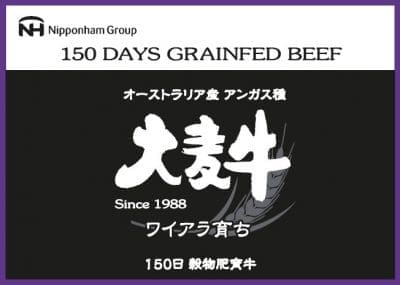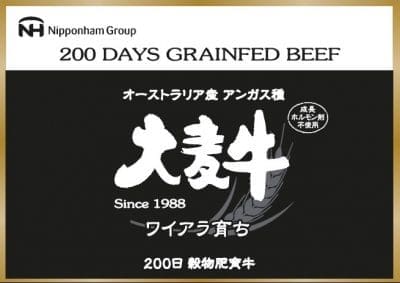IT’S long been said that in order to survive, Australian beef has to distance itself as much as possible from the commodity end of the global beef market, where battles are won and lost largely on price.
Positioning Australian branded beef as a higher quality product, backed by product integrity, traceability and other desirable attributes is seen as the answer, and it’s a strategy being adopted by one of the country’s longest-running export grainfed brand programs.
NH Foods (then known as Nippon Meat Packers Australia) was one of the pioneers of large-scale branded beef products back in the 1990s.
The company launched its Omugi-Gyu (Barley Beef) grainfed brand in the mid-1990s, not that long after the Japanese market liberalised, making direct trading in Australian beef much easier.

Carton lids for the new Omugi Gyu 150 and 200-day Angus programs
Beef Central’s Jon Condon interviewed Mr Okoso, senior executive and son of the Nippon Meats founder, and Ken Hinohara in Japan around the time Omugi Gyu was first launched.
While the name remains virtually unknown in the Australian domestic market, Omugi Gyu quickly took off in Japan, backed by a then-unheard-of A$1 million marketing budget including mainstream television advertising.

It was originally designed as a 180-day shortfed program, supplied solely out of Nippon’s Australian resources, including the large Whyalla feedlot near Texas, and processed at the company’s Oakey plant on Queensland’s Darling Downs.
Over the years there have been various iterations developed, including a brand program called ‘Olive Beef’ where healthy olive oil was added as a ration inclusion. Some cattle were fed on to 130 days. Days-on-feed also shifted somewhat over time to suit Japanese domestic demand and economic circumstances through the late 1990s and into this century.
In Japan – the only country where Omugi Gyu is sold – it became a well-known retail and food service brand, available in better restaurants and hotels, and supermarkets.
Even today, Omugi Gyu is still the key brand that NH Foods is driving into the Japanese market.
Because of the company’s sheer size and diversity in Japan as an importer/distributor, usually the trade is in chilled ‘full-sets’, taking the 12 main primals from each carcase, with different items channelled into different Japanese customers. With a 20 percent share of beef sales in Japan and more than 22,000 staff, NH Foods is well positioned to effectively utilise full-set beef in this way – a distinct advantage over selling single cuts.
Changing consumer preferences
But given changing consumer preferences, and greater competition generally in the global marketplace for grainfed beef, NH Foods is now re-positioning Omugi Gyu in the market.
Two separate brand production streams have been developed:
- An Omugi Gyu Angus program, a 150-day grainfed product supplied by Angus and Angus cross cattle, and
- An Omugi Gyu 200-day grainfed program, supplied by Black Angus only. Both will operate under Angus Australia’s “Verified Angus/Black Angus” QA programs.
That extended days-on-feed strategy is clearly linked with taking the product away from the ‘commodity’ end of the grainfed beef spectrum – especially given the ‘wall of beef’ that’s coming out of the US industry this year and next (see Steve Kay’s monthly US market column published this morning.)
“Shortfed, 100-day beef these days is pretty much a commodity,” NH Foods sales manager Andrew McDonald told Beef Central.
“There’s a niche for it in the domestic market, but in export, 100-day is really a commodity product now. Some brand managers are trying to pull other attributes out of 100-day programs to enhance them a little, such as breed (reference Beef Central’s recent story on S.Kidman’s new 100-day Santa program). But by moving to greater days on feed, we’re looking for higher marbling scores, with greater consistency, from mid-fed cattle,” he said.
For the new 200-day Angus program, even higher marbling scores will be targeted – the equivalent of high-end USDA Choice or low Prime.
As well as the up-shift in meat quality delivered through extended feeding, drawing attention to the brand’s Angus attributes is seen as another brand positioning ‘plus.’
Escaping the commodity trade
The new Omugi Gyu brand specs have been trialled on a low-key basis for the past 12 months, to strong customer approval.

Andrew McDonald, NH Foods
“They understand that Australian beef is safe, its natural, and its quality assured,” Mr McDonald said. “We’re seeing by lifting meat quality through these two programs that we are stepping above competing US product in the Japanese market. We’re avoiding that ‘mainstream, bulk grainfed market’ which is heavily price-driven, by offering something that a discerning niche consumer or restaurant proprietor will see as a premium offer, with a fully-integrated supply chain story behind the brand.”
Increasingly, whether it was grainfed or grassfed, Australian beef needed to be different, newer, better than commodity beef in the export market, Mr McDonald said.
“If we drift into the international ‘hot spots’ for commodity beef from the US, Brazil Argentina, Uruguay or elsewhere, we run the risk of becoming all about price,” he said.
“We can’t beat other suppliers on cost – they are going to be cheaper. Our offer has to be doing it better, and adding value for the customer.”
“That could be through the inherent attributes of the Australian product; it could be through value-adding the product in some way; or traceability or brand story; but we have to leverage off these attributes if we are going to run a successful business going forward, in an increasingly competitive international marketplace.”
“The US is forecast to produce record meat protein for the next few years, so the ‘wall of meat’ isn’t going away any time soon,” he said.
Combined, both new Omugi Gyu programs will account for significant numbers per month of Angus and Black Angus cattle. Given the additional days on feed, carcase weights will be around 400-420kg, based on feeder steer requirements 380-500kg.
“We have seen average marbling scores and consistency improve over time in these 150-day programs, and a lot of that has to do with the improvements in genetics and feed management,” Mr McDonald said.
- NH Foods plans a series of high-profile Omugi Gyu product re-launches in Japan. The company’s Whyalla feedlot is interested to talk to Angus and Angus cross cattle producers over feeder supply. Contact is Stephen Moy 0438 452 925.
- Andrew McDonald speaks at the Queensland Rural Press Club this Thursday.
